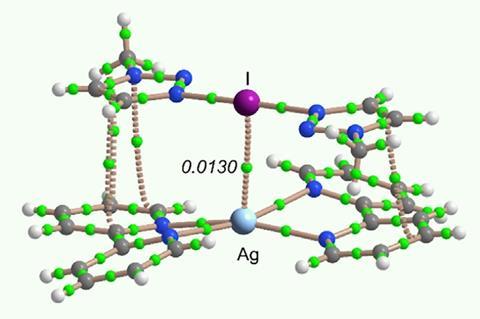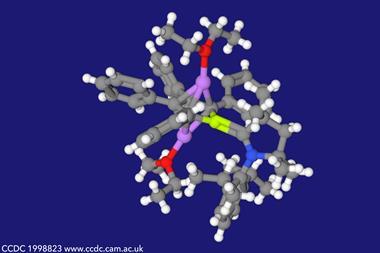
Evidence has been discovered that attractive forces exist between silver and iodonium cations. ‘The interaction is counter-intuitive,’ explains Kari Rissanen from the University of Jyväskylä, Finland. ‘No one would expect two positively charged ions to experience an attractive interaction.’
Rissanen says that his team discovered the attraction serendipitously. They were studying reactions intended to produce a complex containing a positively charged halogen ion, known as a halonium ion, specifically an iodonium ion. These reactions started with one complex that contained a silver ion and another that contained an iodonium ion. The iodonium ion was intended to substitute for the silver ion, but instead the researchers produced a stable ‘complex of complexes’ without any substitution. ‘It would have been easy to dismiss the result as an oddity and move on, but we recognised its potential and began studying it in earnest,’ says Rissanen.
NMR and isothermal calorimetry measurements of the complex in solution then both suggested an attractive interaction happening between the silver and iodonium ions. X-ray diffraction studies of crystals of the complex also showed that the silver and iodonium ions were closer together than would be expected without an attractive interaction. The researchers attribute the attraction to an as yet unnamed interaction. They suggest that the iodonium ion donates an electron to the silver cation. While being formally positively charged, the iodonium ion acts as a nucleophile.
Rissanen notes that the combination of data from the complexes in solution and as crystals makes a stronger case that the two cations interact like this. Otherwise the interaction ‘might have been written off as simply a consequence of other well-known interactions’. Antonio Frontera from the University of the Balearic Islands, Spain, also used computational chemistry to show that other interactions were not responsible.
Pierangelo Metrangolo from the Polytechnic University of Milan, Italy, notes that the evidence for the complex of complexes is very robust. Rissanen’s team makes it three different ways, and the characterisation is thorough. ‘There are still many intermolecular interactions to be discovered,’ he stresses. ‘The nature of many others, even established ones, is yet to be fully understood.’
The Jyväskylä team has now synthesised different examples that demonstrate the same new interaction, Rissanen adds. He hopes to use the interaction to stabilise a wide range of systems. ‘The scientific community will be seeing a lot more of this work in the near future.’
References
S Yu et al, Chem, 2021, DOI: 10.1016/j.chempr.2021.01.003

















No comments yet